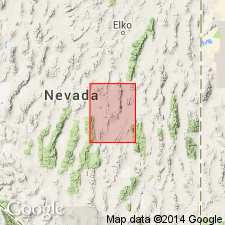
- Usage in publication:
-
- Antelope Valley limestone*
- Modifications:
-
- Original reference
- Dominant lithology:
-
- Limestone
- AAPG geologic province:
-
- Great Basin province
Summary:
Pg. 28-29, pls. 1, 2. Antelope Valley limestone of Pogonip group. Named applied to uppermost formation in Pogonip Group. Dominantly thick-bedded or massive, medium-gray or light-bluish gray, fine-grained limestone. Very little chert present. Cliff-forming units not uncommon. Locally contains thinner bedded zones, as at base of formation on Martins Ridge [Martin Ridge], where there is about 150 feet of rather thinly bedded argillaceous limestone. Here, formation not separable from underlying Ninemile formation (new) on basis of change from thinner bedded to thicker bedded limestone, but color change in thin-bedded rocks is distinctive. Thinner bedded limestones present near top of formation both in Antelope Valley and at Eureka. In this part of section, limestone tends to be flaggy or platy with tan argillaceous partings and mottlings, although limestone still retains medium-gray to light-blulsh-gray color in bulk of unit. Thickness about 400 feet near Eureka; about 1,100 feet at Martins Ridge. In type area, underlies Copenhagen formation [see Merriam, 1963]; in Eureka district proper, underlies Eureka quartzite. Fossils [listed]. Age is Middle Ordovician based on abundant fauna identified by C.W. Merriam.
Named from occurrence in Antelope Valley region, Eureka and Nye Cos., central NV. Well exposed on [Martin Ridge], a linear northward-trending ridge that separates Copenhagen Canyon from Antelope Valley and is about [35 mi] southwest of Eureka, [in T. 15 N., R. 49 E., Lat. 39 deg. 10 min. 02 sec. N., Long. 116 deg. 23 min. 18 sec. W., Horse Heaven Mountain 15-min quadrangle], central NV.
[Additional locality information from USGS GNIS database and USGS historical topographic map collection TopoView, accessed Memorial Day, 2018.]
Source: US geologic names lexicon (USGS Bull. 1200, p. 108-109); supplemental information from GNU records (USGS DDS-6; Menlo GNULEX).
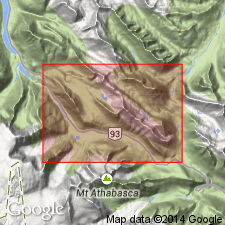
- Usage in publication:
-
- Antelope Valley limestone*
- Modifications:
-
- Age modified
- AAPG geologic province:
-
- Great Basin province
Summary:
E. Kirk and G.A. Cooper (in Duncan, 1956) agreed that Chazy and therefore Antelope Valley limestone is late Early Ordovician rather than early Middle Ordovician.
Source: GNU records (USGS DDS-6; Menlo GNULEX).
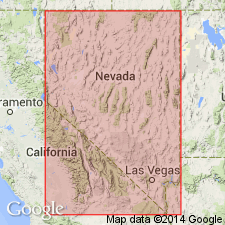
- Usage in publication:
-
- Antelope Valley limestone*
- Modifications:
-
- Areal extent
- AAPG geologic province:
-
- Great Basin province
Summary:
Pg. 97 (fig. 3), 98 (fig. 4). Antelope Valley limestone. In Toquima Range, overlies Stoneberger shale (new); underlies Caesar Canyon formation or Diana formation (both new). [Age is Lower and Middle Ordovician.]
Source: US geologic names lexicon (USGS Bull. 1200, p. 108-109).
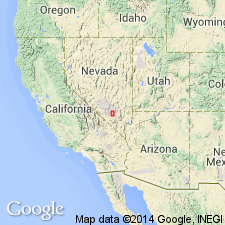
- Usage in publication:
-
- Antelope Valley Limestone*
- Modifications:
-
- Revised
- AAPG geologic province:
-
- Great Basin province
Summary:
Pg. C108, C110 (fig. 189.1). Antelope Valley limestone of Pogonip group. In Nevada Test Site area, subdivided into (ascending) Paiute Ridge, Ranger Mountains, and Aysees members (all new). Age is Early and Middle Ordovician.
Source: Publication; GNU records (USGS DDS-6; Menlo GNULEX).
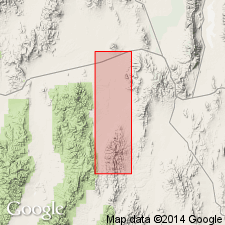
- Usage in publication:
-
- Antelope Valley Limestone*
- Modifications:
-
- Age modified
- AAPG geologic province:
-
- Great Basin province
Summary:
Age of Antelope Valley limestone changed from Middle Ordovician to Early and Middle Ordovician.
Source: GNU records (USGS DDS-6; Menlo GNULEX).
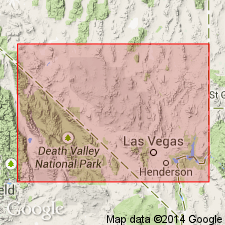
- Usage in publication:
-
- Antelope Valley Limestone*
- Modifications:
-
- Biostratigraphic dating
- AAPG geologic province:
-
- Great Basin province
Summary:
Antelope Valley Limestone of Pogonip Group. Correlated from Dry Mountain area, California, to Arrow Canyon Range area, Nevada. Underlies Eureka Quartzite. Gradationally overlies Ninemile Formation. Is partly age-equivalent to Badger Flat Limestone of Mazourka Group in Inyo Mountains, California. Fossils [listed]; carries abundant stromatolite GIRVANELLA, gastropods PALLISERIA and MACLURITES, and trilobite KIRKELLA. Trilobites collected from limestones above the Ninemile Formation, at Ninemile Canyon in the Antelope Range, belong to the PSEUDOCYBELE NASUTA fauna, = zone J of Ross (1951) and of Hintze (1952), and approx. = graptolite zone DIDYMOGRAPTUS PROTOBIFIDUS of Ross and Berry (1963, table 1). [Almost identical specimens assigned to ORTHIDIELLA zone by Nolan and others, 1956]. Base of Antelope Valley at type section is correlative both faunally and lithically with base of Paiute Ridge Member in Nevada Test Site area.
Source: Publication.
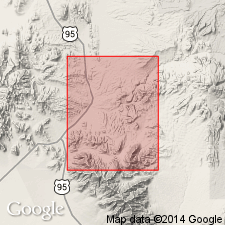
- Usage in publication:
-
- Antelope Valley Limestone*
- Modifications:
-
- Age modified
- Biostratigraphic dating
- AAPG geologic province:
-
- Great Basin province
Summary:
Antelope Valley Limestone (or Antelope Valley Formation). Recognized in southern Nevada and southeastern California. Age changed from Early and Middle Ordovician --to-- Middle Ordovician, based on studies of mudmounds with STROMATACTIS structures.
Source: GNU records (USGS DDS-6; Menlo GNULEX); Changes in stratigraphic nomenclature, 1975 (USGS Bull. 1422-A, p. A2-A3).
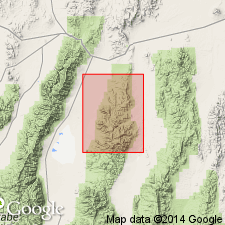
- Usage in publication:
-
- Antelope Valley Limestone*
- Modifications:
-
- Age modified
- AAPG geologic province:
-
- Great Basin province
Summary:
Pg. 6 (fig. 4), 11-13, pls. (geol. map, cross section). Antelope Valley Limestone of Pogonip Group. Recognized in June Canyon, Mill Canyon, August Canyon, and Petes Canyon sequences of the eastern carbonate assemblage in Toquima Range area, Lander, Nye, and Eureka Counties, central Nevada. Consists of thin- to medium-bedded, grayish-blue limestone with irregular patches that weather yellow orange. In most places forms cliffs or steep slopes. Thickness about 700 to 900+ feet. Overlies Ninemile Formation of Pogonip Group. Contact is gradational across a stratigraphic interval of about 50 feet, and the boundary is placed at the horizon above which limestone forms more than 50 percent of the section. Where Ninemile absent, disconformably overlies Goodwin Limestone of Pogonip Group. Unconformably underlies Caesar Canyon Limestone, Hanson Creek Formation, or unnamed limestone units. Diagnostic fossils include GIRVANELLA, RECEPTACULITES, PALLISARIA, and MACLURITES. In study area, age is considered Middle Ordovician.
Source: Publication.
For more information, please contact Nancy Stamm, Geologic Names Committee Secretary.
Asterisk (*) indicates published by U.S. Geological Survey authors.
"No current usage" (†) implies that a name has been abandoned or has fallen into disuse. Former usage and, if known, replacement name given in parentheses ( ).
Slash (/) indicates name conflicts with nomenclatural guidelines (CSN, 1933; ACSN, 1961, 1970; NACSN, 1983, 2005, 2021). May be explained within brackets ([ ]).

